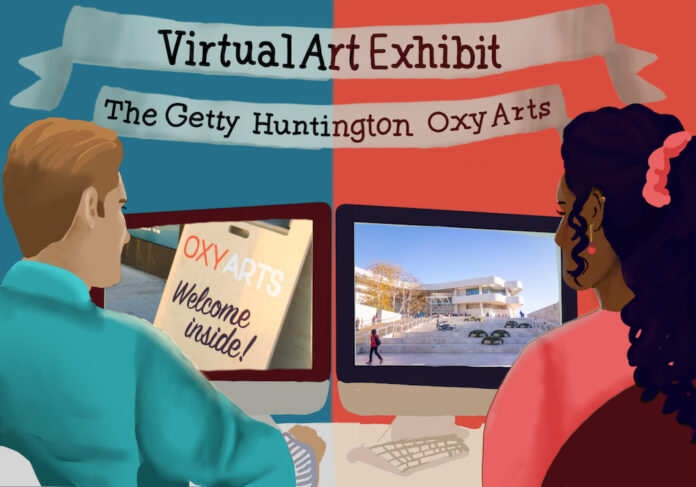LA museums and art organizations closed their doors March 2020 due to the COVID-19 pandemic, and they were not able to reopen for over a year, costing them millions of dollars in lost revenue. About a year later, LA art venues started to allow visitors at 25 percent capacity as of March 15. As visitors were unable to visit LA museums and art organizations in person, they have accelerated their online programming and social media initiatives to engage with a global audience.
At the beginning of the pandemic, professor Phillip E. Bloom, former Art & Art History professor at Occidental, curator of the Chinese Garden and director of the Center for East Asian Garden Studies at the Huntington, said that the institution did not move very much online. When the gardens reopened in July, Bloom said that the institution began doing online programs during the summer. Some of the projects he worked on included a digital map of the calligraphy in the garden and a lecture series.
“I do not think I anticipated just how much we would be relying on technology for everything once the pandemic started, nor how much I would crave non-digital experiences — specifically, interaction with nature and with physical art objects,” Bloom said via email.
Professor Stephanie Schrader ’90, former Art and Art History professor at Occidental and curator of drawings at the J. Paul Getty Museum (the Getty), has also been giving Zoom lectures to students both domestically and internationally. According to Schrader, the Getty Museum Challenge was the most successful campaign from the museum to connect to its visitors at the beginning of the pandemic, and it received thousands of submissions on Twitter, Facebook and Instagram. Schrader said the challenge was an opportunity for visitors to recreate the Getty’s paintings and objects at home with food and other household items.
“It was less about having the curators tell you what to think about the work, but, rather, you responding to the work by creating a work of art yourself,” Schrader said.
Meldia Yesayan, the Director of Oxy Arts, said that the organization also took advantage of digital platforms to create opportunities for expanded accessibility and participation. According to her, Oxy Arts used projected programs on the back wall of its building, digital lesson plans and interactive videos to connect with both its local and digital audiences.
Yesayan said that one of the first projects from Oxy Arts at the beginning of the pandemic was in partnership with In Plain Sight, a National Coalition of artists and activists, who presented a series of real and virtual skywriting to make visible the injustices of detention facilities and immigration in the United States. This collaboration continued as a virtual exhibition at Oxy Arts, consisting of a 3D virtual tour of the space. According to Yesayan, visitors could navigate through the gallery and spend as much time as they wanted at each work.
“Now that we’ve understood what’s capable with technology, there’s really no turning back because there’s so much that we can do,” Yesayan said.
This summer, Oxy Arts is launching “Encoding Futures: Speculative Monuments for LA,” a remote residency program with five LA artists to research and think about the future of monuments in the United States, according to Yesayan. She said that each artist will conceive an original virtual monument to be geo-located at a LA community and site. The monuments will be accessible for the public to view through the 4th Wall app.
According to Schrader, COVID-19 has made many museums rely on digital platforms to engage people with their art. Although many people can access the Getty’s collections without the costs of traveling to LA, Schrader said that she is conflicted about the digital push during the pandemic, because she wants more people to look at art but does not want to compromise the viewing experience.
“Ultimately, I’m a curator of objects, and I want people to have the experience with the small intimate things that they look at, noticing the paper, pen marks and chalk marks. You can’t get that on a screen,” Schrader said.
Schrader said that she will visit the Getty in two weeks to help set up an exhibition titled “Artist as Collectors,” which will be open to the public May 25.
“It won’t be the huge crowds like we had before, but that might be actually a nice viewing experience for people,” Schrader said. “It’ll be less chaotic and hectic and more contemplative and pleasant.”
Similar to Schrader, Bloom said staff members and visitors have experienced a serious learning curve for the Huntington’s new digital initiatives, but despite growing pains, the pandemic encouraged the institution to embrace digital technology. According to Bloom, his lecture series on East Asian garden history now attracts 200–500 views worldwide.
“I think that digital programming will prove especially useful in the future,” Bloom said via email. “We now can easily make programs and exhibitions permanently available online, which means they can be accessed by far more diverse audiences — particularly students and teachers — than ever before.”
Bloom also said that hopes that the museums and other cultural institutions will continue to offer online or hybrid programs to become more inclusive organizations. According to him, digital programming will prove useful in the future if museums wish to remain vital institutions.
“The racism and xenophobia that we have seen over the past year have reinforced how important it is for arts organizations to redouble their efforts to educate the public and to encourage cross-cultural understanding and empathy,” Bloom said via email.
![]()



































